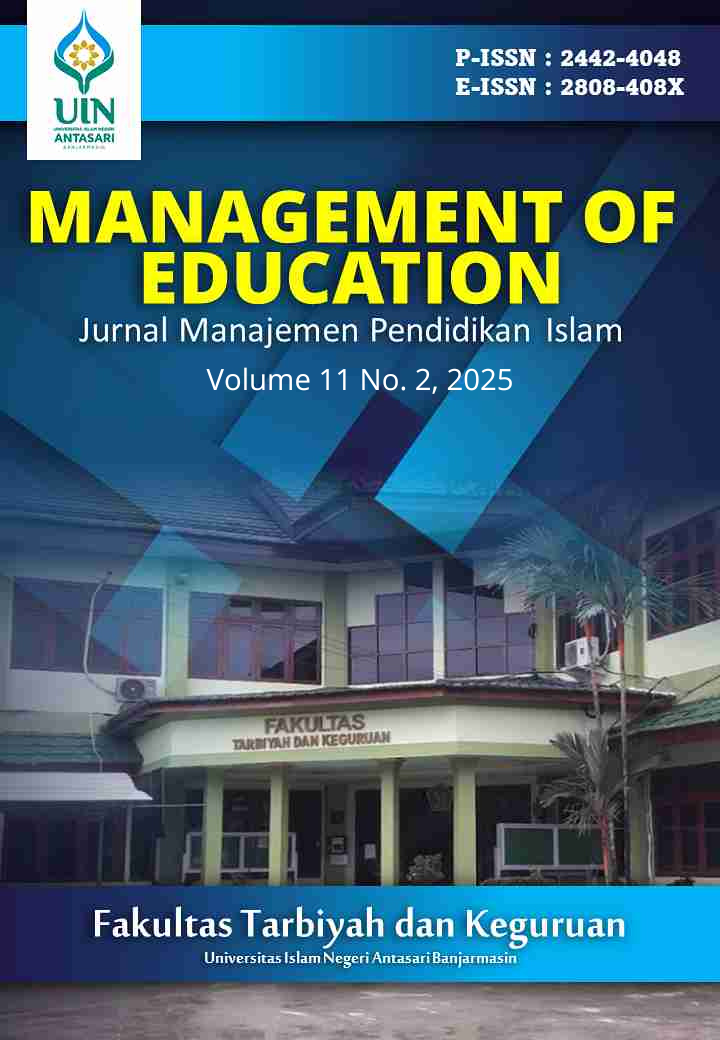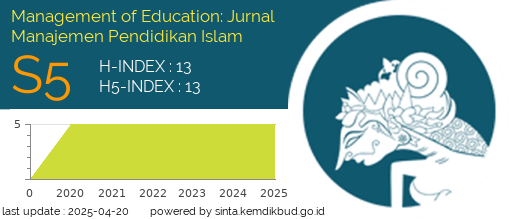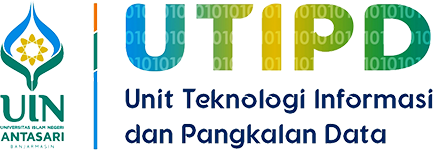Evaluating the SAVA System as a Digital-Based Quality Strategy in Islamic Schools: A CIPP Model Approach
DOI:
https://doi.org/10.18592/moe.v11i2.17412Keywords:
SAVA system, CIPP model, educational quality, Islamic schools, continuous improvementAbstract
This study evaluates the implementation of the SAVA system as a digital-based quality management strategy at SDIT Ar-Rahmah, Indonesia, using the CIPP (Context, Input, Process, Product) evaluation model. The research was conducted through a qualitative descriptive approach, employing interviews, observations, and documentation, with data analysis following Miles and Huberman’s interactive model. The findings reveal that the SAVA system was adopted in response to contextual needs for systematic monitoring of academic and affective services. In terms of input, teacher training, adequate infrastructure, and strong parental involvement provided the foundation for implementation. The process dimension highlighted comprehensive academic strategies including teacher training, supervision, use of digital media, and project-based assessments alongside affective strategies such as daily Islamic practices, character-building programs, and social activities, all integrated into the SAVA system. The product dimension demonstrated measurable impacts: efficiency in report preparation, increased student motivation, and observable improvements in honesty, discipline, and cooperation. Despite these achievements, challenges remain, particularly the absence of a mobile version and the need for automatic notifications. Theoretically, this study contributes to the literature on educational quality management by showing how digital innovation can be systematically combined with values-based education in Islamic schools. Practically, it offers a best-practice model for holistic quality assurance, integrating academic excellence with character development through data-driven strategies.References
Creswell, J. W., & Poth, C. N. (2018). Qualitative inquiry and research design: Choosing among five approaches (4th ed.). Sage.
Darling-Hammond, L., Flook, L., Cook-Harvey, C., Barron, B., & Osher, D. (2020). Implications for educational practice of the science of learning and development. Applied Developmental Science, 24(2), 97–140. https://doi.org/10.1080/10888691.2018.1537791
Dwisusanti, R., & Mukhroji, M. (2025). Siklus TQM Dalam Pendidikan: Planning, Do, Check, Act Dalam Dunia Pendidikan, Prinsip Kaizen Pada TQM . MANAJERIAL : Jurnal Inovasi Manajemen Dan Supervisi Pendidikan, 5(2), 328-338. https://doi.org/10.51878/manajerial.v5i2.5381
Díez-Gutiérrez, E. J., & Gajardo-Espinoza, C. (2020). Educating and evaluating in times of coronavirus: The situation in Spain. Multidisciplinary Journal of Educational Research, 10(2), 102–134. https://doi.org/10.4471/remie.2020.5604
Epstein, J. L. (2018). School, family, and community partnerships: Preparing educators and improving schools (2nd ed.). Routledge.
Frimayanti, A. I. (2015). Latar Belakang Sosial Berdirinya Lembaga Pendidikan Islam Terpadu di Indonesia. Al-Tadzkiyyah: pendidikan Islam, 6(1), 27–45. https://doi.org/10.24042/atjpi.v6i1.1476
Herawati, A., Dewi, S. P., Marati, S. N., & Sari, H. P. (2025). Peran Pendidikan Islam Dalam Membangun Karakter Generasi Muda di Tengah Arus Globalisasi. Ihsan: Journal of Islamic Education, 3(2), 370–380. https://doi.org/10.61104/ihsan.v3i2.987
Karimulah, A., & Ummah, N. I. (2022). Pelaksanaan Supervisi Akademik Kepala Madrasah Sebagai Upaya Meningkatkan Profesionalisme Guru Untuk Memotivasi Belajar Siswa MTs Muqoddimatul Akhlak Curah Wungkal Silo Jember. Southeast Asian Journal of Islamic Education Management, 3(1), 13-34. https://doi.org/10.21154/sajiem.v3i1.74
Merriam, S. B., & Tisdell, E. J. (2016). Qualitative research: A guide to design and implementation (4th ed.). Jossey-Bass.
Miles, M. B., Huberman, A. M., & Saldaña, J. (2014). Qualitative data analysis: A methods sourcebook (3rd ed.). Sage.
Neumann, J., Robson, A., & Sloan, D. (2018). Monitoring and evaluation of strategic change program implementation: Lessons from a case analysis. Evaluation and Program Planning, 66, 120–132. https://doi.org/10.1016/j.evalprogplan.2017.09.012
OECD. (2019). OECD Future of Education and Skills 2030: OECD Learning Compass 2030. OECD Publishing.
Paputungan. E., & Paputungan. F. (2023). The Role and Function of Affective approaches in learning. Journal of Education and Culture (JEaC), 3(1), 57-65. https://doi.org/10.47918/jeac.v3i1.1136
Rismawati, R., Ibrahim, T., & Arifudin, O. (2024). Peran sistem informasi dalam meningkatkan mutu layanan pendidikan. Jurnal Tahsinia, 5(7), 1099–1122. https://doi.org/10.57171/jt.v5i7.618
Sahid, D. R., & Rachlan, E. R. (2019). Pengelolaan Fasilitas Pembelajaran Guru dalam Meningkatkan Mutu Pembelajaran Pendidikan Jasmani di Sekolah Menengah Kejuruan (SMK). Indonesian Journal of Education Management & Administration Review, 3(1), 26–39. http://nbn-resolving.de/urn:nbn:de:4321ijemar.v3i1.29452
Stufflebeam, D. L. (2003). The CIPP model for evaluation. In T. Kellaghan & D. L. Stufflebeam (Eds.), International handbook of educational evaluation (pp. 31–62). Springer. https://doi.org/10.1007/978-94-010-0309-4_4
Syafaruddin. (2002). Integrated quality management in education. Gramedia.
Utami, PR, Marlia, A., Putra, S., Dwiyanti, A., Ridwan, M., & Setiani, A. (2025). Nilai-Nilai Budaya Islam Klasik dalam Pembentukan Karakter: Upaya Revitalisasi untuk Generasi Bangsa. Journal of Social Sciences and Humanities , 1 (2), 212–219. https://doi.org/10.63822/nzxrgk19
Yandi, A., Nathania, A., Putri, K., & Syaza, Y. (2023). Factors affecting student learning outcomes: A literature review. Jurnal Pendidikan Siber Nusantara, 1(1), 13–24. https://doi.org/10.38035/jpsn.v1i1
Yasin, I. (2021). Problem Kultural Peningkatan Mutu Pendidikan di Indonesia: Perspektif Total Quality Management. Ainara Journal (Jurnal Penelitian Dan PKM Bidang Ilmu Pendidikan), 2(3), 239–246. https://doi.org/10.54371/ainj.v2i3.87
Downloads
Published
How to Cite
Issue
Section
License
Copyright (c) 2025 Muh Hisyam, Mardhiah Hasan

This work is licensed under a Creative Commons Attribution 4.0 International License.
Authors who publish with this journal agree to the following terms:
- Authors retain copyright and grant the journal right of first publication with the work simultaneously licensed under a Creative Commons Attribution 4.0 International that allows others to share the work with an acknowledgement of the work's authorship and initial publication in this journal.
- Authors are able to enter into separate, additional contractual arrangements for the non-exclusive distribution of the journal's published version of the work (e.g., post it to an institutional repository or publish it in a book), with an acknowledgement of its initial publication in this journal.
- Authors are permitted and encouraged to post their work online (e.g., in institutional repositories or on their website) prior to and during the submission process, as it can lead to productive exchanges, as well as earlier and greater citation of published work.









 This work is licensed under a
This work is licensed under a 